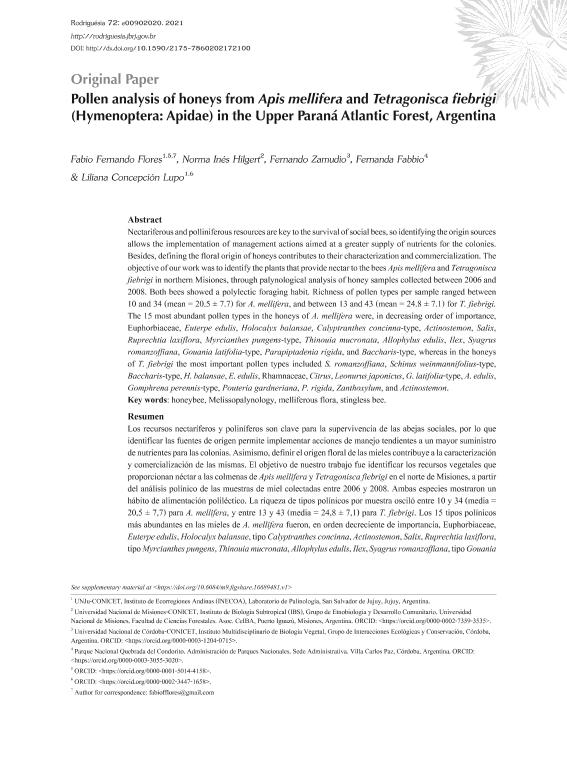Artículo
Pollen analysis of honeys from Apis mellifera and Tetragonisca fiebrigi (Hymenoptera: Apidae) in the Upper Paraná Atlantic Forest, Argentina
Flores, Fabio Fernando ; Hilgert, Norma Ines
; Hilgert, Norma Ines ; Zamudio, Fernando
; Zamudio, Fernando ; Fabbio, Fernanda; Lupo, Liliana Concepcion
; Fabbio, Fernanda; Lupo, Liliana Concepcion
 ; Hilgert, Norma Ines
; Hilgert, Norma Ines ; Zamudio, Fernando
; Zamudio, Fernando ; Fabbio, Fernanda; Lupo, Liliana Concepcion
; Fabbio, Fernanda; Lupo, Liliana Concepcion
Fecha de publicación:
10/2021
Editorial:
Instituto de Pesquisas Jardim Botanico do Rio de Janeiro
Revista:
Rodriguésia
ISSN:
0370-6583
Idioma:
Inglés
Tipo de recurso:
Artículo publicado
Clasificación temática:
Resumen
Nectariferous and polliniferous resources are key to the survival of social bees, so identifying the origin sources allows the implementation of management actions aimed at a greater supply of nutrients for the colonies. Besides, defining the floral origin of honeys contributes to their characterization and commercialization. The objective of our work was to identify the plants that provide nectar to the bees Apis mellifera and Tetragonisca fiebrigi in northern Misiones, through palynological analysis of honey samples collected between 2006 and 2008. Both bees showed a polylectic foraging habit. Richness of pollen types per sample ranged between 10 and 34 (mean=20.5±7.7) for A. mellifera, and between 13 and 43 (mean=24.8±7.1) for T. fiebrigi. The 15 most abundant pollen types in the honeys of A. mellifera were, in decreasing order of importance, Euphorbiaceae, Euterpe edulis, Holocalyx balansae, Calyptranthes concinna-type, Actinostemon, Salix, Ruprechtia laxiflora, Myrcianthes pungens-type, Thinouia mucronata, Allophylus edulis, Ilex, Syagrus romanzoffiana, Gouania latifolia-type, Parapiptadenia rigida, and Baccharis-type, whereas in the honeys of T. fiebrigi the most important pollen types included S. romanzoffiana, Schinus weinmannifolius-type, Baccharis-type, H. balansae, E. edulis, Rhamnaceae, Citrus, Leonurus japonicus, G. latifolia-type, A. edulis, Gomphrena perennis-type, Pouteria gardneriana, P. rigida, Zanthoxylum, and Actinostemon.
Palabras clave:
HONEYBEE
,
MELISSOPALYNOLOGY
,
MELLIFEROUS FLORA
,
STINGLESS BEE
Archivos asociados
Licencia
Identificadores
Colecciones
Articulos(INECOA)
Articulos de INSTITUTO DE ECORREGIONES ANDINAS
Articulos de INSTITUTO DE ECORREGIONES ANDINAS
Citación
Flores, Fabio Fernando; Hilgert, Norma Ines; Zamudio, Fernando; Fabbio, Fernanda; Lupo, Liliana Concepcion; Pollen analysis of honeys from Apis mellifera and Tetragonisca fiebrigi (Hymenoptera: Apidae) in the Upper Paraná Atlantic Forest, Argentina; Instituto de Pesquisas Jardim Botanico do Rio de Janeiro; Rodriguésia; 72; 10-2021
Compartir
Altmétricas



